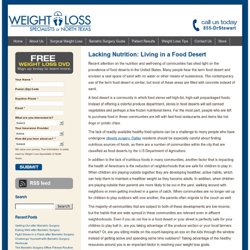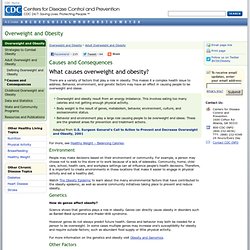

Lacking Nutrition: Living in a Food Desert. Recent attention on the nutrition and well-being of communities has shed light on the prevalence of food deserts in the United States.

Many people hear the term food desert and envision a vast space of sand with no water or other means of sustenance. The contemporary use of the term food desert is similar, but most of these areas are filled with concrete instead of sand. A food desert is a community in which food stores sell high-fat, high-salt prepackaged foods. Instead of offering a colorful produce department, stores in food deserts will sell canned vegetables and perhaps a few frozen nutritional items. For the most part, people who are left to purchase food in these communities are left with fast-food restaurants and items like hot dogs or potato chips. Food Empowerment Project. Food deserts can be described as geographic areas where residents’ access to affordable, healthy food options (especially fresh fruits and vegetables) is restricted or nonexistent due to the absence of grocery stores within convenient travelling distance.

For instance, according to a report prepared for Congress by the Economic Research Service of the US Department of Agriculture, about 2.3 million people (or 2.2 percent of all US households) live more than one mile away from a supermarket and do not own a car. [1] In urban areas, access to public transportation may help residents overcome the difficulties posed by distance, but economic forces have driven grocery stores out of many cities in recent years, making them so few and far between that an individual’s food shopping trip may require taking several buses or trains.
In suburban and rural areas, public transportation is either very limited or unavailable, with supermarkets often many miles away from people’s homes. References: School of Public Health » The Obesity Prevention Source » Toxic Food Environment. How Our Surroundings Influence What We Eat What we choose to eat plays a large role in determining our risk of gaining too much weight. But our choices are shaped by the complex world in which we live—by the kinds of food our parents make available at home, by how far we live from the nearest supermarket or fast food restaurant, even by the ways that governments support farmers. ( 1 - 4 ) In the U.S. and many parts of the world, the so-called food environment—the physical and social surroundings that influence what we eat—makes it far too hard to choose healthy foods, and all too easy to choose unhealthy foods. Food deserts may not be key in what people eat, study says. There's no strong evidence of an association between living within… (Mel Melcon / Los Angeles ) There’s no strong evidence of an association between living within walking distance of places to buy food and being overweight or not, researchers said after interviewing nearly 100,000 Californians.
Given the attention to the idea of food deserts – areas with limited access to healthful food – and their effect on people’s health, the researchers wanted to find how much it mattered to have stores and restaurants within walking distance, which they defined as a mile from home. What Causes Overweight and Obesity. Send a link to NHLBI to someone by E-MAIL | PRINT PAGE | PRINT ENTIRE TOPIC | SHARE this page from the NHLBI BOOKMARK & SHARE Click here to close.

X Click here to view disclaimer. Disclaimer Share this page from the NHLBI on Blogger. Blogger Share this page from the NHLBI on Buzz. Buzz Share this page from the NHLBI on Delicious. Delicious Share this page from the NHLBI on Digg. The causes of obesity - genes, behaviour and the environment. How calorie balance is controlled In ten years, an average person eats about 10 million calories but their weight typically only changes by about 10 pounds either way.

So in most cases, our weight remains stable over time. This is because our bodies control our calorie balance very precisely; much like a thermostat keeps the temperature of a room steady. Our genes and our environment both affect the setting of this ‘weight thermostat’ and can cause a calorie imbalance. For example, our genes can affect the amounts and types of food that we prefer to eat. So most of the time, our body weight is controlled by instinctive drives. The environment Obesity is becoming more and more common. Food tastes better, is available in more varieties, and is cheaper, especially processed foods. We are also living more inactive lifestyles. Cancer Research UK believes that we need a comprehensive strategy to halt the rise in obesity in the UK population, particularly in children and young adults.
Genes. Obesity and Overweight for Professionals: Adult: Causes - DNPAO - CDC. What causes overweight and obesity?

There are a variety of factors that play a role in obesity. This makes it a complex health issue to address. Behavior, environment, and genetic factors may have an effect in causing people to be overweight and obese. For more, see Healthy Weight – Balancing Calories. Environment People may make decisions based on their environment or community. Watch The Obesity Epidemic to learn about the many environmental factors that have contributed to the obesity epidemic, as well as several community initiatives taking place to prevent and reduce obesity. Genetics How do genes affect obesity? Science shows that genetics plays a role in obesity. However genes do not always predict future health.